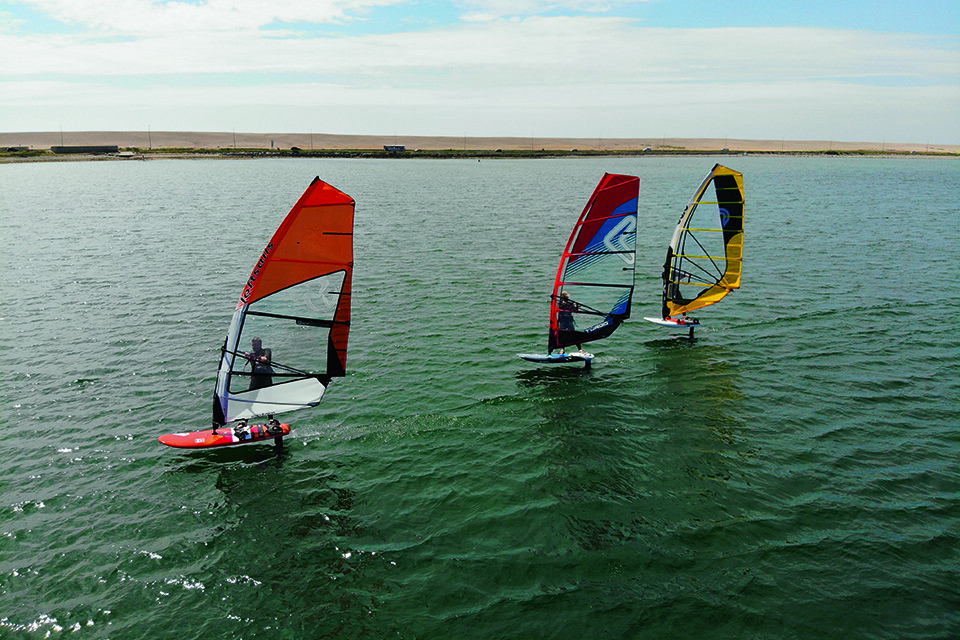FLIGHT’S PRIMARY IGNITION
FREERIDE FOIL SAIL TEST 2019
Test Editor Tris Best // Second Testers Maurin Rottenwalter, Joe North & Dan Hallam.
Photos Dan Hallam & Tris Best // Test location Portland Harbour.
The parameters suggested to the brands for our inaugural wind foil sail test were left incredibly broad and open, for one simple reason. We wanted them to decide which product to put forward, and in doing so provide some understanding of their design direction. A sort of litmus paper test to gauge whether there was a consensus amongst the largest sail lofts.
This test was originally published in the July 2019 issue.
When wind foiling first came into the limelight, one of the most alluring points was its perceived ability to inject life into light marginal winds. There were plenty of bold statements made by various brands that full foiling bliss could be achieved easily in less than 10 knots … but in reality, even spicing up those 10-15 knot days was a real draw. With the introduction of the new power source, the ability to reduce the sail size used was compelling – no one would grumble at being able to use a smaller sail, with the obvious upside of ease and handling.
Step forward a few years and the progression in foil and board technology has been meteoric. The change in the sail’s role has also been analysed, understood and evolved, leading to many foil-specific designs appearing. Our brief to the brands for this review was to provide sails for foiling use in winds between 10-18 knots. It has given rise to an eclectic bunch of sails, in sizes from 7.8m to 5.8m, which is testament to the belief of many that when foiling a rider can get away with sails two square metres smaller … or two sail sizes down from the sails normally used.
FINDINGS
Stepping back to grass roots for a moment, when learning how to foil for the first time, it is not inconceivable for a rider to use the same size sail they’d use for normal windsurfing initially, particularly the heavier sailor.
The reason is that it is so engrained in windsurfers that the sail is the sole power source, waiting for the sail to provide feedback through the hands before a step rearwards to engage the foil is even contemplated. It also means the board used has to be of conventional form, with enough waterline and rocker-flat to let the rider drive power into it through their extended front foot. In truth, good foiling technique is more akin to poor conventional windsurfing skills! Stand back early, stamp through the back foot and once flying, stand tall, hinging at the waist with your heels down! It is why experienced windsurfers sometimes take longer to fall in love with foiling, as they have to undo years of learning … and it feels sacrificial!
Learn to manipulate the foil efficiently and the sail becomes purely an early fuel-injector in the initial gust, enabling the rider to get water flowing over the foil’s wings enough to be able stand back into position to work the foil.
Once going, the sail then needs to adopt a profile that tunes itself efficiently to the more head-on apparent wind direction. The sail itself can de-power and become neutral for handling ease, deferring to the power of the foil to keep driving the board through lulls and manoeuvres. Much like a large wave rider tries to get away with the smallest sail possible, to account for the power the wave will provide once flying down the face, so too can a foiler opt for the small sail to account for the new energy source soon to kick in below the board.
Imagine the sail size chosen by big wave windfoil riders! We wait with bated breath. With lightness and handling ease now at the fore, sailing harness free is now entirely feasible … and certainly a bonus if you’re thinking of sailing strapless too. At the other end of the scale, foiling competition has seen racers steadily scale up the size of sail they’re using, resulting in nigh on parity between the sail sizes used for foil racing compared to slalom. In fact, with the arms race ensuing towards ever increasing high aspect race foil sails (deemed to provide more drive and efficiency in the light airs), the sail sizes adopted are now closer to Formula windsurfing and an increasingly niche product.
The priorities for a sail to perform well for foiling are largely similar to those desired in a quality conventional rig. Whether it be through a reduced luff curve, extended Dacron luff panel, high sail geometry or refined batten structure, the key attribute consistent with most is the ability to breathe and generate useful bottom end power as soon as possible. This should, of course, not be at the expense of sail stability, ensuring plenty of range. The decision on which sail size and style to get is largely down to ensuring it complements the board and foil size/style you intend to use it with. And as with board and foil choice, the type of foiling you’re interested in is likely to be reflective of your own normal windsurfing preference in the first instance.
SUMMARY
Starting with the conventional twin-cams on test (the crossover sails for foiling and normal sailing), we have the Severne Turbo GT that found great favour with most that tried it. Light handling, soft and very pumpable, its low down camber placement allowed the rest of the sail to release and spring for pumping efficiency. Just take heed of its light handling in marginal winds; be subtle and resist the easy trap of over-sheeting. The Simmer 2XC has a similar ease, opting for a much longer boom and rider-focussed centre of effort to mitigate the effect of a more solid profile. Neil Pryde’s V8 goes the other way, being high aspect in nature, with an extra batten to provide more structure. Its power is certainly more subtle in marginal winds, requiring extra rider input, but once up to speed, its efficiency shines through. That leaves the Goya Mark 2 – the first cammed sail tested from this loft. With masses of luff curve, it feels large and stiff in the hands and requires real rider involvement and technique to get the most from in ‘sub-planing’ wind strengths. Yet as the wind increases, its acceleration and efficiency (both on and off the foil) make it a very rewarding sail to use. Onto foiling specific sails and the closest comparison to the Goya is the Loftsails Skyscape, a highly structured sail that benefits from a reduced batten configuration for accessible foil blasting across a wide wind range. The last three sails extol the virtues of an alternative path, trying to use as small a sail as possible for manoeuvre-oriented freeride foiling. The Duotone is a feature rich contender, with such a soft easy nature that can’t help but accelerate your foiling progression. The Ezzy Hydra is a unique looking sail, from a brand whose conventional sails already have distinguished design traits that make them great for foiling as well! Last but by no means least, there’s the Compact Freefoil from RRD – a sail that combines foiling attributes with the practicality of the brand’s unique travel bag compact concept. And with the introduction of sub 200 cm foiling boards, the marriage of the two ideas has never been more relevant.
THE LINE UP


